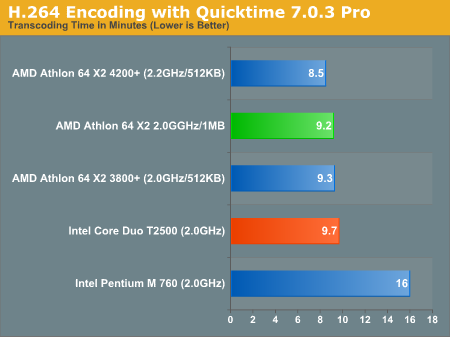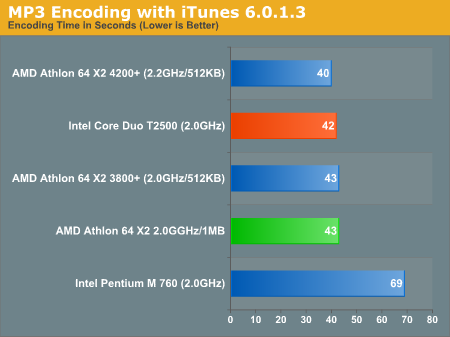Intel Core Duo (Yonah) Performance Preview - Part II
by Anand Lal Shimpi on December 19, 2005 12:55 PM EST- Posted in
- CPUs
Media Encoding Performance with DVD Shrink, WME, Quicktime and iTunes
We were most curious about the Core Duo's media encoding performance, given that a number of the optimizations for the new processor were FP/SSE related. We've updated our entire media encoding test suite, including everything from the one-click DVD ripping utility DVD Shrink to including H.264 encoding performance with Quicktime 7.0.3 Pro. We wanted to include the latest version of DivX in this comparison. However, the recent release of DivX 6.1 left us with a few bugs that we're still trying to work out in our test beds, so we had to exclude it. However, as time goes on, H.264 encoding will quickly become far more important than even looking at DivX, so its omission from this article isn't as big of a loss in terms of forward-looking performance.
First up is DVD Shrink 3.2.0.15. Our test was simple - we took a copy of Star Wars Episode VI and ripped the full DVD to the hard drive without compression, effectively giving us an exact copy of the disc on the hard drive. Then, using the copy of the DVD on the hard drive (to eliminate any DVD drive bottlenecks), we performed a DVD shrink operation to shrink the movie to fit on a single 4.5GB DVD disc. All of the options were left on their defaults, so the test ends up being pretty easy to run and reproduce. The scores reported are DVD encoding times in minutes, with lower numbers meaning better performance.
The DVD Shrink test is quite important as DVD Shrink is quite possibly one of the easiest tools to rip a DVD. The easier a tool is to use, the more likely it's going to be used, and arguably the more important performance using it happens to be.
Moving on, we have our Windows Media Encoder 9 test, which uses the advanced profile settings for video encoding. We left all settings at their defaults and just proceeded with a MPEG-2 to WMV-HD conversion. The values reported are in frames per second, with higher numbers being better.
Next up, we have Quicktime Pro 7.0.3 and we perform a MPEG-2 to H.264 encoding task. All of the settings are left at their defaults, with the exception that we optimize the output file for download with a 256kbps data rate while leaving the resolution untouched. We also adjust the video options to optimize for the best quality. We report the transcoding time in minutes, with lower values being better.
Finally, we have a MP3 encoding test using iTunes 6.0.1.3. For this test, we simply took a 304MB wav file and converted it to a 192kbps MP3 file, measuring the encode time in seconds. The only iTunes option that we changed was to prevent the playback of the song while encoding.
We were most curious about the Core Duo's media encoding performance, given that a number of the optimizations for the new processor were FP/SSE related. We've updated our entire media encoding test suite, including everything from the one-click DVD ripping utility DVD Shrink to including H.264 encoding performance with Quicktime 7.0.3 Pro. We wanted to include the latest version of DivX in this comparison. However, the recent release of DivX 6.1 left us with a few bugs that we're still trying to work out in our test beds, so we had to exclude it. However, as time goes on, H.264 encoding will quickly become far more important than even looking at DivX, so its omission from this article isn't as big of a loss in terms of forward-looking performance.
First up is DVD Shrink 3.2.0.15. Our test was simple - we took a copy of Star Wars Episode VI and ripped the full DVD to the hard drive without compression, effectively giving us an exact copy of the disc on the hard drive. Then, using the copy of the DVD on the hard drive (to eliminate any DVD drive bottlenecks), we performed a DVD shrink operation to shrink the movie to fit on a single 4.5GB DVD disc. All of the options were left on their defaults, so the test ends up being pretty easy to run and reproduce. The scores reported are DVD encoding times in minutes, with lower numbers meaning better performance.
The DVD Shrink test is quite important as DVD Shrink is quite possibly one of the easiest tools to rip a DVD. The easier a tool is to use, the more likely it's going to be used, and arguably the more important performance using it happens to be.

- The Pentium M performs exceptionally poorly, and
- The Core Duo performs exceptionally well.
Moving on, we have our Windows Media Encoder 9 test, which uses the advanced profile settings for video encoding. We left all settings at their defaults and just proceeded with a MPEG-2 to WMV-HD conversion. The values reported are in frames per second, with higher numbers being better.

Next up, we have Quicktime Pro 7.0.3 and we perform a MPEG-2 to H.264 encoding task. All of the settings are left at their defaults, with the exception that we optimize the output file for download with a 256kbps data rate while leaving the resolution untouched. We also adjust the video options to optimize for the best quality. We report the transcoding time in minutes, with lower values being better.

Finally, we have a MP3 encoding test using iTunes 6.0.1.3. For this test, we simply took a 304MB wav file and converted it to a 192kbps MP3 file, measuring the encode time in seconds. The only iTunes option that we changed was to prevent the playback of the song while encoding.

Professional Application Performance with 3dsmax, Adobe Premier and Photoshop
Gaming Performance with Battlefield 2 and Black & White 2










103 Comments
View All Comments
ozzimark - Monday, December 19, 2005 - link
they've got some headroom with clocks to play with, as the recent opterons are showing ;)Beenthere - Monday, December 19, 2005 - link
...and I'm sure some gillible sheep will buy into it.Since the "review" tested apples to oranges AGAIN, it's not of much value for anyone looking to purchase a notebook PC because you used a desktop X2 for comparison to Intel's YAWNER -- a dual core laptop chippie.
To quote this story:
"Intel’s Core Duo launches in January at CES, so if you’ve been thinking about buying a new laptop, we’d suggest waiting at least another month or so. You won’t be disappointed. "
-- Now if that ain't fanboy, what is???
Obviously with Turion stealing a lot of sales from Centrino, it's no surprise Intel is stroking the media to gain as much positive hype on uncompetitive products as it can since it knows it will be at least '07 if not later before it can compete with AMD in any market segment based on performance, value and power consumption. That however won't stop the Intel shilling.
stateofbeasley - Monday, December 19, 2005 - link
AnandTech is one of the most fair review sites on the net and has been one of the biggest champions of AMD products for years. Your "comments" are little more than pathetic insults against Anand, who is and always will be more credible than you.Furen - Monday, December 19, 2005 - link
I think that he is right to some extent, though. I was hoping for a power consumption comparison between Dothan and Yonah to see which one is better for battery life but it never materialized. I would not say that AMD has a Turion that can compete with Yonah but testing Yonah in a desktop setting and then concluding that it's a heck of a laptop chip without comparing it to other laptop chips leaves a bit to be desired. Also, the tone of this review seemed a quite a bit more Intel-appeasing, if you please, as there was nothing in this review that we didn't see before except for flowery praise about how Yonah does very well without an on-die mem controller.That said I must say that all the asking for a 2GHz 1MB L2/core A64 was pretty retarded. There is no 2GHz 1MB/core SKU so including a fake one just for comparison does not really help since there's no way to get something even similar (the 4400+ is the lowest-clocked 1MB L2 X2). It would have been nice to see an X2 4600+ (the second-best A64 SKU) compared to this Yonah (the second-best one) but I guess the 4200+ is more inline with its price.
SpinJaunt - Wednesday, December 21, 2005 - link
An overclocked Opteron 165 or underclocked Opteron 175 might have been an idea? forget about prices.
I think AMD still has some tricks up there sleeves regardless of what there roadmaps might say.
Anemone - Tuesday, December 20, 2005 - link
Eliminating clockspeed and using the best cache available sets the baseline for comparison, by keeping as few items of difference between the chips as possible. I fully agree with the choice, and, moreover, am quite positive there will be something out in the Turion line that will be quite similar to the 2ghz, dual channel, 1m/core cache that was used for testing.I think it's kind of funny to see us finally returning to tests where comparing close to exactly the same clockspeed produces even mildly comparable results. I say that because years ago that's what we used to do all the time, and finally things have come nearly full circle.
:)
Furen - Tuesday, December 20, 2005 - link
Ah, but we still don't know how DDR2 will affect K8 (or K9, as AMD likes to call the dual-cores) performance. Maybe AMD will increase the L2 cache data width from 128bits to 256bits (the Pentium M has a 256bit interface) to make up for the additional latency, though I doubt it.vijay333 - Monday, December 19, 2005 - link
"Now if that ain't fanboy, what is???"It's called giving good advice. Not an Intel owner myself, but even I would appreciate this info as AT obviously has more info on this. Would you rather buy a laptop now and then regret the purchase when something much better comes along in just a month from now? AT is not telling you to buy an Intel based machine, just to wait a month to get a better idea of what your options are. If you have read AT for a while, you should know that they are definitely not biased towards Intel...
tfranzese - Monday, December 19, 2005 - link
Something new and better will always be out "a month from now". Get use to it.bob661 - Monday, December 19, 2005 - link
Looks like just a P-M with two cores to me. Whoop-de-doo.